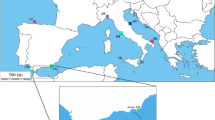Abstract
Previously, a very low level of divergence between the species of the genus Salamandrella—S. keyserlingii and S. schrenckii—was detected on the basis of variability of the nucleotide sequences of three genes of the nuclear genome (BDNF, POMC, and RAG1). Fixed interspecific differences were detected only in one nucleotide position of the RAG1 gene, and the level of interspecific divergence for this gene was only 0.07%. In this paper, we present the results of a study of the variability of the ENC1, MGAT4C, and RAG2 nuclear genes. The level of interspecific divergence for the MGAT4C gene was 0.14%, and for the RAG2 gene, it was 0.8%. The results of a phylogenetic analysis of the nucleotide sequences of the RAG2 gene in representatives of the family Hynobiidae indicate that the separation of the Salamandrella branch, which is basal for the genera Batrachuperus, Liua, Hynobius, and Pseudohynobius, occurred approximately 55 million years ago. The time of divergence between species of the Salamandrella genus was approximately 21 million years ago.
Similar content being viewed by others
References
Berman, D.I., Derenko, M.V., Malyarchuk, B.A., et al., Intraspecific genetic differentiation of Siberian newt (Salamandrella keyserlingii, Amphibia, Caudata) and cryptic species S. schrenkii from the Russian southeast, Zool. Zh., 2005, vol. 84, no. 11, pp. 1374–1388.
Matsui, M., Yoshikawa, N., Tominaga, A., et al., Phylogenetic relationships of two Salamandrella species as revealed by mitochondrial DNA and allozyme variation (Amphibia: Caudata: Hynobiidae), Mol. Phylogenet. Evol., 2008, vol. 48, pp. 84–93. doi 10.1016/j.ympev. 2008.04.010
Poyarkov, N.A. and Kuzmin, S.L., Phylogeography of the Siberian newt Salamandrella keyserlingii by mitochondrial DNA sequence analysis, Russ. J. Genet., 2008, vol. 44, no. 8, pp. 948–958. doi 10.1134/S1022795408080097
Berman, D.I., Derenko, M.V., Malyarchuk, B.A., et al., The area and genetic polymorphism of Schrenck newt [Amphibia, Caudata, Hynobiidae, Salamandrella schrenckii (Strauch, 1870)], Zool. Zh., 2009, vol. 88, no. 5, pp. 530–545.
Malyarchuk, B., Derenko, M., Berman, D., et al., Phylogeography and molecular adaptation of Siberian salamander Salamandrella keyserlingii based on mitochondrial DNA variability, Mol. Phylogenet. Evol., 2010, vol. 56, pp. 562–571. doi 10.1016/j.ympev.2010.04.005
Malyarchuk, B., Derenko, M., and Denisova, G., Phylogeny and genetic history of the Siberian salamander (Salamandrella keyserlingii, Dybowski, 1870) inferred from complete mitochondrial genomes, Mol. Phylogenet. Evol., 2013, vol. 67, pp. 348–357. doi 10.1016/j. ympev.2013.02.004
Malyarchuk, B.A., Derenko, M.V., and Denisova, G.A., Phylogenetic relationships among Asiatic salamanders of the genus Salamandrella based on variability of nuclear genes, Russ. J. Genet., 2015, vol. 51, no. 1, pp. 91–97. doi 10.1134/S102279541501007X
Berman, D.I., Leirikh, A.N., and Mikhailova, E.I., On the wintering of Siberian newt, Hynobius keyserlingii in the upper Kolyma, Zh. Evol. Biokhim. Fiziol., 1984, vol. 20, no. 3, pp. 323–327.
Malyarchuk, B.A., Derenko, M.V., and Denisova, G.A., Episodes of adaptive evolution of mitochondrial genome in Asiatic salamanders (Amphibia, Caudata, Hynobiidae), Russ. J. Genet., 2014, vol. 50, no. 2, pp. 168–174. doi 10.1134/S1022795414020070
Malyarchuk, B.A., Selective processes and adaptive evolution of the cytochrome b gene in salamanders of the genus Salamandrella, Russ. J. Genet., 2012, vol. 48, no. 6, pp. 605–610. doi 10.1134/S1022795412040084
Zheng, Y., Peng, R., Kuro-o, M., and Zeng, X., Exploring patterns and extent of bias in estimating divergence time from mitochondrial DNA sequence data in a particular lineage: a case study of salamanders (Order Caudata), Mol. Biol. Evol., 2011, vol. 28, pp. 2521–2535. doi 10.1093/molbev/msr072
Chen, M.-Y., Mao, R.-L., Liang, D., et al., A reinvestigation of phylogeny and divergence times of Hynobiidae (Amphibia, Caudata) based on 29 nuclear genes, Mol. Phylogenet. Evol., 2015, vol. 83, pp. 1–6. doi 10.1016/j.ympev.2014.10.010
Poyarkov, N.A., Phylogenetic relations and taxonomy of tailed amphibians of the newt family (Amphibia: Caudata, Hynobiidae), Extended Abstract of Cand. Sci. Dissertation, Mosk. Gos. Univ., Moscow, 2010.
Shen, X.X., Liang, D., Feng, Y.J., et al., A versatile and highly efficient toolkit including 102 nuclear markers for vertebrate phylogenomics, tested by resolving the higher level relationships of the Caudata, Mol. Biol. Evol., 2013, vol. 30, pp. 2235–2248. doi 10.1093/molbev/mst122
Tamura, K., Peterson, D., Peterson, N., Stecher, G., Nei, M., and Kumar, S., MEGA5: molecular evolutionary genetics analysis using maximum likelihood, evolutionary distance, and maximum parsimony methods, Mol. Biol. Evol., 2011, vol. 28, pp. 2731–2739. doi 10.1093/molbev/msr121
Excoffier, L., Laval, G., and Schneider, S., Arlequin ver. 3.0: an integrated software package for population genetics data analysis, Evol. Bioinf. Online, 2007, vol. 1, pp. 47–50. PMCID: PMC2658868
Drummond, A.J., Suchard, M.A., Xie, D., and Rambaut, A., Bayesian phylogenetics with BEAUti and the BEAST 1.7, Mol. Biol. Evol., 2012, vol. 29, pp. 1969–1973. doi 10.1093/molbev/mss075
Gao, K.Q. and Shubin, N.H., Earliest known crown group salamanders, Nature, 2003, vol. 422, pp. 424–428. doi 10.1038/nature01491
Schatz, D.G., Oettinger, M.A., and Baltimore, D., The V(D)J recombination activating gene, RAG-1, Cell, 1989, vol. 59, pp. 1035–1048. PMID: 2598259
Litman, G.W., Rast, J.P., and Fugmann, S.D., The origins of vertebrate adaptive immunity, Nat. Rev. Immunol., 2010, vol. 10, pp. 543–553. doi 10.1038/nri2807
Guo, Z.T., Ruddiman, W.F., Hao, Q.Z., et al., Onset of Asian desertification by 22 Myr ago inferred from loess deposits in China, Nature, 2002, vol. 416, pp. 159–163. doi 10.1038/416159a
Author information
Authors and Affiliations
Corresponding author
Additional information
Original Russian Text © B.A. Malyarchuk, M.V. Derenko, A.N. Litvinov, 2018, published in Genetika, 2018, Vol. 54, No. 7.
Rights and permissions
About this article
Cite this article
Malyarchuk, B.A., Derenko, M.V. & Litvinov, A.N. High Level of Interspecific Divergence in the Salamandrella Genus Based on Variability of the RAG2 Gene. Russ J Genet 54, 832–837 (2018). https://doi.org/10.1134/S1022795418070098
Received:
Accepted:
Published:
Issue Date:
DOI: https://doi.org/10.1134/S1022795418070098



